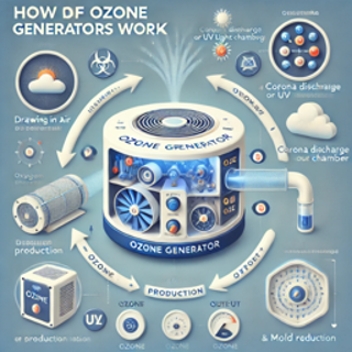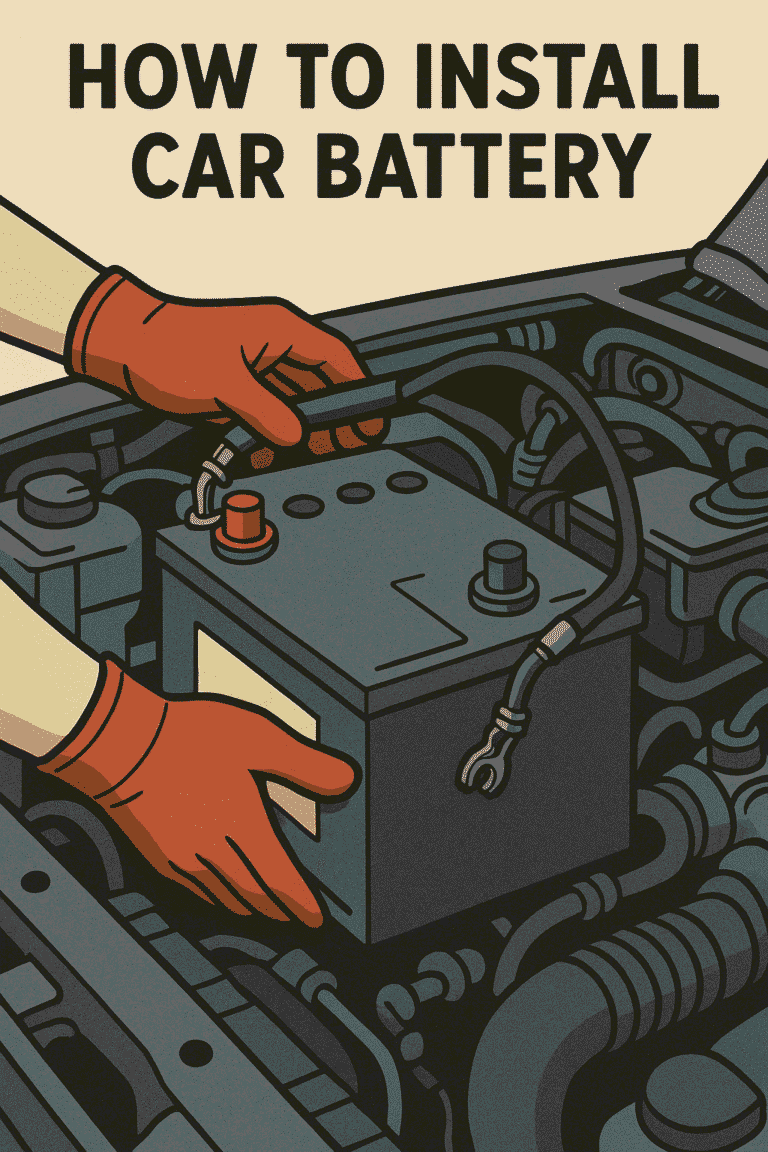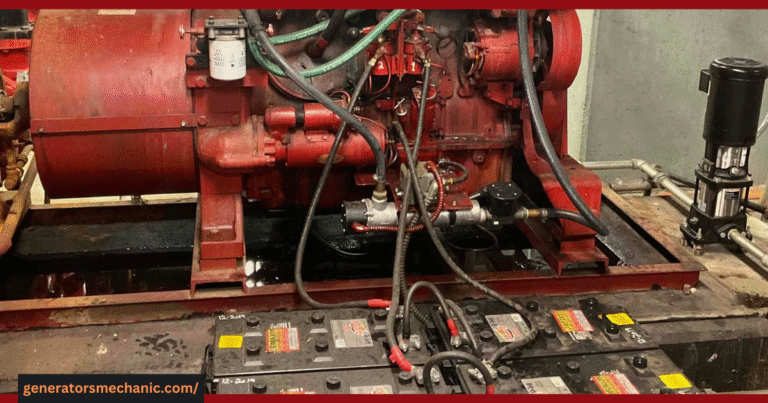How Do Ozone Generators Work? 5 Powerful Benefits Explained Clearly
Ozone generators are devices designed to produce ozone, a gas made of three oxygen atoms, that can help reduce odors, bacteria, and pollutants in the air. They release controlled amounts of ozone into the space, where it reacts with airborne particles and neutralizes them. This makes them popular in settings where eliminating strong smells or sanitizing the environment is necessary.
If you’re wondering how ozone generators work to clean the air, the process is quite simple yet powerful. The ozone binds with pollutants like smoke, mold spores, or allergens, breaking them down into less harmful compounds. While effective, it’s important to use ozone generators carefully and only in unoccupied spaces, as high levels of ozone can be unsafe for humans and pets.

Ozone generators are fascinating devices that produce ozone, a powerful oxidant, to help purify air and eliminate unwanted odors. But how do ozone generators work? In this guide, we’ll break down the science behind these machines, explore their various applications, and discuss the benefits and safety considerations of using ozone. Whether you’re looking to improve air quality or tackle stubborn smells, understanding how ozone generators function can help you make informed decisions about their use.
Key Takeaways
- Ozone generators convert oxygen (O2) into ozone (O3) using electrical charges or UV light.
- They are effective for air purification, odor removal, and water treatment.
- Ozone acts as a strong disinfectant, eliminating harmful bacteria and viruses.
- Safety is crucial; overexposure to ozone can be harmful to health.
- Choosing the right ozone generator involves considering your specific needs and reading user reviews.
How Ozone Generators Function
Ozone generators are designed to purify air by producing ozone (O₃), a molecule known for its ability to neutralize odors, bacteria, and other pollutants. These machines work by converting oxygen into ozone, which then reacts with airborne contaminants, breaking them down into less harmful compounds. This process makes them popular for eliminating tough odors like smoke, mold, and pet smells.
Many people curious about this technology often ask online, especially in forums like How do ozone generators work Reddit, where users share their real-life experiences and insights. While these discussions highlight the effectiveness of ozone generators, they also emphasize the importance of using them responsibly, as high levels of ozone can be harmful if not managed properly.

Understanding the Ozone Generation Process
So, how do these ozone generators actually work? It’s not magic, but it’s pretty cool. Ozone generators convert regular oxygen (O2) into ozone (O3). This happens through a couple of different methods, but the end result is the same: that extra oxygen atom is ready to get to work.
- First, the generator takes in ambient air.
- Then, it applies energy to the oxygen molecules.
- Finally, the O2 molecules split and reform as O3.
Ozone is unstable, which is why it’s so reactive. That third oxygen atom is just itching to attach to something else, and that’s how it neutralizes odors and disinfects.
The Role of Electrical Charges
Electrical charges are key to ozone generation. Think of it like this: you’re giving the oxygen molecules a jolt to get them to rearrange. One common method is corona discharge, where a high-voltage electrical field splits the oxygen molecules. It’s kind of like a tiny lightning storm inside the machine. This process breaks the bonds holding the two oxygen atoms together, freeing them to bond with other O2 molecules and form O3. The amount of electrical charge influences the concentration of ozone produced. It’s a delicate balance, because too much ozone can be harmful, but the right amount can be really effective at air purification.
Types of Ozone Generators
There are a few different types of ozone generators out there, each with its own way of creating ozone. The two main types are:
- Corona discharge ozone generators: These use high voltage electricity to split oxygen molecules.
- UV ozone generators: These use ultraviolet light to achieve the same effect.
- Ceramic plate ozone generators: These are a variation of corona discharge, using ceramic plates to generate the electrical field.
Each type has its pros and cons in terms of efficiency, cost, and the amount of ozone it produces. For example, UV ozone generators tend to produce lower concentrations of ozone compared to corona discharge generators. The choice depends on the specific application and the desired ozone output.
Applications of Ozone Generators
Ozone generators are widely used in different industries because of their ability to purify air and water effectively. From removing odors in homes and vehicles to sterilizing medical equipment, these machines provide a safe and eco-friendly way to improve environments. Their versatility makes them valuable for residential, commercial, and industrial applications.
One of the most notable uses is in water purification. If you’re wondering how an ozone generator works in water treatment, the process involves releasing ozone gas into the water, which destroys bacteria, viruses, and other harmful contaminants. This ensures clean, safe, and fresh-tasting water without the need for harsh chemicals. Such applications make ozone generators an important tool for maintaining health and hygiene.
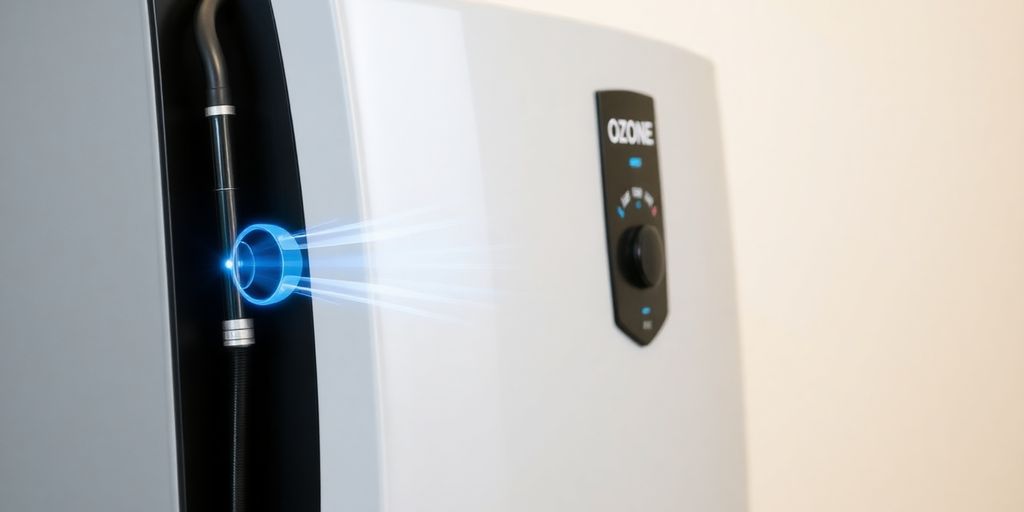
Air Purification
Ozone generators are often used to purify the air in homes and businesses. They can help remove odors, mold, and other pollutants. I remember when my neighbor used one after a small kitchen fire; it really helped get rid of the smoke smell. It’s pretty amazing how effective they can be.
- Removes smoke
- Eliminates mold spores
- Reduces allergens
Ozone generators work by producing ozone (O3), which is a molecule made up of three oxygen atoms. This molecule is unstable and reacts with pollutants in the air, breaking them down into less harmful substances.
Odour Elimination
One of the most common uses for ozone generators is to get rid of bad smells. Ozone can neutralize odors from pets, smoke, cooking, and even things like mildew. I’ve seen them used in cars, apartments, and even in gyms to combat that lingering sweat smell. It’s a pretty versatile solution for neutralizing odors.
- Pet odors
- Smoke odors
- Cooking odors
Water Treatment
Ozone is also used in water treatment to disinfect and purify water. It can kill bacteria, viruses, and other microorganisms, making the water safer to drink or use for other purposes. It’s often used in municipal water treatment plants, but also in smaller systems for homes or businesses. It’s a pretty effective way to treat water.
|
Contaminant |
Removal Rate |
|
Bacteria |
99.9% |
|
Viruses |
99.9% |
|
Protozoa |
99.9% |
Benefits of Using Ozone
Ozone generators have gained popularity as effective tools for improving air quality and creating a healthier environment. They work by producing ozone, which helps neutralize odors, reduce airborne pollutants, and eliminate harmful bacteria or mold from the air. For homeowners and businesses, these devices can make indoor spaces feel fresher and more comfortable.
One of the most talked-about advantages is the range of ozone machine benefits. From removing stubborn smoke smells to sanitizing rooms naturally, ozone machines offer a powerful solution for keeping spaces clean without relying heavily on chemical-based products. This makes them an attractive choice for people who value both convenience and eco-friendly living.
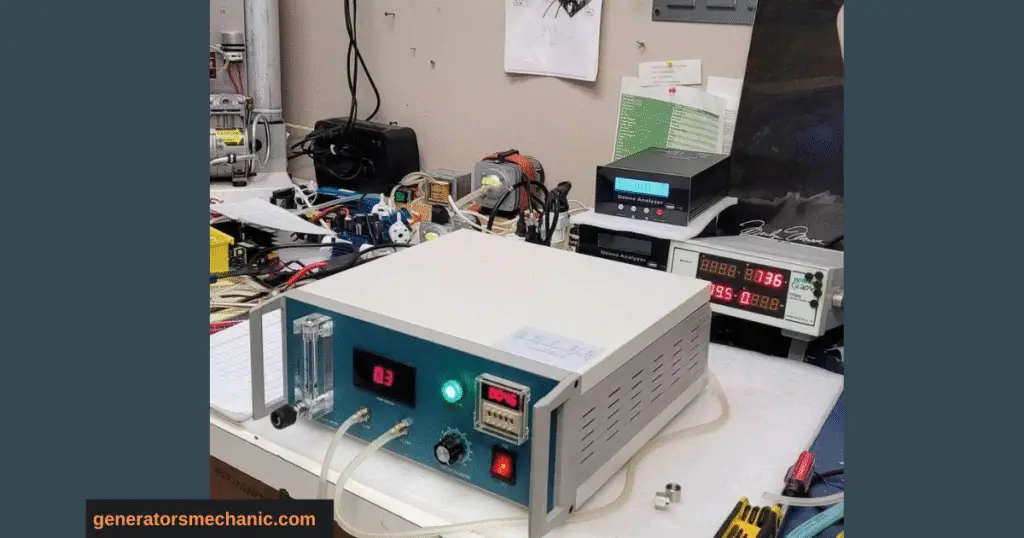
Effective Disinfection
Ozone is a really strong disinfectant. It can wipe out bacteria, viruses, and fungi super effectively. Think of it as a natural way to clean things up without harsh chemicals. It’s used in all sorts of places, from hospitals to homes, to keep things clean and reduce the spread of germs. It’s way more effective than some other methods, and it gets the job done quickly. For example, ozone therapy is sometimes explored as an alternative medicine.
Odour Neutralization
One of the coolest things about ozone is how it gets rid of bad smells. Instead of just covering them up, it breaks down the stuff that causes the odours in the first place. So, whether it’s smoke, pet smells, or something else funky, ozone can actually eliminate it. It’s like a breath of fresh air, literally. I used it once after a small kitchen fire, and it worked wonders. Air fresheners just don’t compare; they only mask the problem, while ozone tackles it head-on. It’s a game-changer for anyone dealing with persistent odours.
Environmental Impact
Ozone is pretty eco-friendly. It breaks down into oxygen, so it doesn’t leave behind harmful stuff like some chemical cleaners do. It’s a natural way to disinfect and clean without polluting the environment. Plus, it can reduce the need for other, less eco-friendly products. It’s a win-win for cleanliness and the planet. It’s good to know that you can clean effectively without harming the environment. It’s a small step, but it makes a difference.
Using ozone is a great way to keep things clean and fresh without relying on harsh chemicals. It’s effective, environmentally friendly, and can make a big difference in the air quality of your home or workplace.
Safety Considerations for Ozone Use
Using an ozone generator can be effective for eliminating odors and disinfecting spaces, but safety should always be the top priority. Ozone is a powerful oxidizing agent, and while it works well for cleaning the air, exposure can be harmful if not handled properly. Always operate the machine in unoccupied areas and ensure good ventilation before re-entry.
One of the most common questions people ask is how long to wait after using an ozone generator. The answer usually depends on the size of the room and the amount of ozone produced, but as a general rule, it’s best to wait several hours before going back inside. This waiting period allows the ozone to dissipate, ensuring the air is safe to breathe again. Taking these precautions will help you get the benefits of ozone cleaning without compromising safety.

Ozone generators can be super useful, but it’s really important to understand the safety side of things. Overdoing it with ozone can be bad news for your health, so let’s walk through some key points to keep in mind.
Health Risks of Ozone Exposure
Okay, so ozone is great at cleaning stuff, but it’s also a lung irritant. Breathing in too much ozone can cause a bunch of problems, like coughing, shortness of breath, and even make asthma worse. Long-term exposure might lead to more serious respiratory issues. It’s not something to mess around with. Also, it’s worth noting that what’s safe for disinfecting isn’t necessarily safe to breathe directly. So, using ozone generators as air purifiers in places where people hang out isn’t usually a good idea. Always check the ozone generator manual for specific advice.
Guidelines for Safe Operation
Using an ozone generator safely isn’t rocket science, but you gotta pay attention. Here’s the deal:
- Only use it in empty spaces: Make sure no people, pets, or plants are in the room when you’re running the generator. Everyone should clear out before the ozone treatment starts.
- Ventilate afterward: Once you’re done, open up the windows and doors to air out the room. Ozone breaks down into oxygen over time, but good ventilation speeds things up.
- Follow the instructions: Seriously, read the manual. Every generator is a little different, and the manufacturer knows best. Pay attention to their recommendations for use and exposure times.
It’s important to manage the use of ozone generators carefully and stick to safety guidelines. Too much ozone can hurt your health, so always respect the recommended amounts and how long you expose yourself to it.
Signs of Overexposure
Knowing the signs of ozone overexposure can help you react quickly. If you start experiencing any of these symptoms, get to fresh air ASAP:
- Coughing or throat irritation
- Shortness of breath or chest pain
- Headache
- Eye irritation
If you notice any of these, turn off the generator, ventilate the area, and if symptoms are severe, seek medical attention. It’s better to be safe than sorry. For applications where ozone safety is a must, consider using an ozone monitor.
Choosing the Right Ozone Generator
Selecting the right ozone generator can make a big difference in improving indoor air quality and eliminating stubborn odors. The right choice depends on factors like the size of your space, safety features, and how frequently you plan to use it. A high-quality ozone generator should balance efficiency with ease of use, ensuring that your home remains fresh and healthy without complications.
For homeowners wondering how to use an ozone generator in the home, it’s important to remember that safety is key. These devices should only be used in unoccupied spaces, and after treatment, proper ventilation is necessary before re-entering. By choosing the right model and following correct usage practices, you can enjoy clean air and a safer living environment.

So, you’re thinking about getting an ozone generator? Cool. There are a few things to keep in mind before you drop your cash. It’s not as simple as just picking the cheapest one you can find. Let’s break it down.
Factors to Consider
Okay, first up, what are you actually trying to do with this thing? Are you trying to get rid of that lingering cat smell, or are you trying to sanitize an entire warehouse? The size of the space matters, big time. You’ll need to match the ozone output to the area you’re treating.
Here’s a quick rundown of things to think about:
- Room Size: This is the big one. A small generator in a large space won’t do much. Choosing the appropriate size is key.
- Ozone Output: Measured in milligrams per hour (mg/h). Higher output means faster and more effective treatment, but also more potential risk if you’re not careful.
- Frequency of Use: Are you planning on using this daily, weekly, or just once in a blue moon? Some generators are built for heavy use, others are better for occasional jobs.
- Features: Timers, remote controls, and different operating modes can make your life easier. But they also add to the cost.
Don’t just grab the first ozone generator you see. Take a minute to think about what you need it for, and how often you’ll be using it. It’ll save you headaches later.
Comparing Different Models
Alright, so you know what you need. Now it’s time to look at what’s out there. There are a ton of different ozone generators on the market, and they’re not all created equal. Some use UV light, others use corona discharge. Some are portable, others are meant to be mounted.
Here’s a basic comparison table:
|
Feature |
UV Ozone Generator |
Corona Discharge Ozone Generator |
|
Ozone Output |
Lower |
Higher |
|
Energy Efficiency |
Lower |
Higher |
|
Maintenance |
More Frequent |
Less Frequent |
|
Cost |
Lower Initial Cost |
Higher Initial Cost |
User Reviews and Recommendations
Don’t just take the manufacturer’s word for it. See what other people are saying. Read reviews, check out forums, and get a feel for what real users think of different models. Pay attention to complaints about reliability, ease of use, and customer service. A generator might look great on paper, but if everyone says it breaks down after a month, you’ll want to steer clear. Look for models that have a solid track record and positive feedback from a wide range of users. It’s worth spending a little extra time researching to avoid ending up with a lemon.
Maintenance and Care for Ozone Generators
Proper maintenance and care are key to ensuring that your ozone generator runs safely and effectively for years. Regularly cleaning the unit, checking filters, and following manufacturer guidelines will help maintain its efficiency. Since ozone can be powerful, it’s important to use the machine responsibly and always allow treated areas to ventilate before re-entering.
Many people wonder, do ozone machines work to remove smells? The answer is yes, when maintained correctly, they can be highly effective in neutralizing odors caused by smoke, mold, or pets. However, keeping your ozone generator in good condition directly impacts how well it performs, making routine care just as important as proper usage.
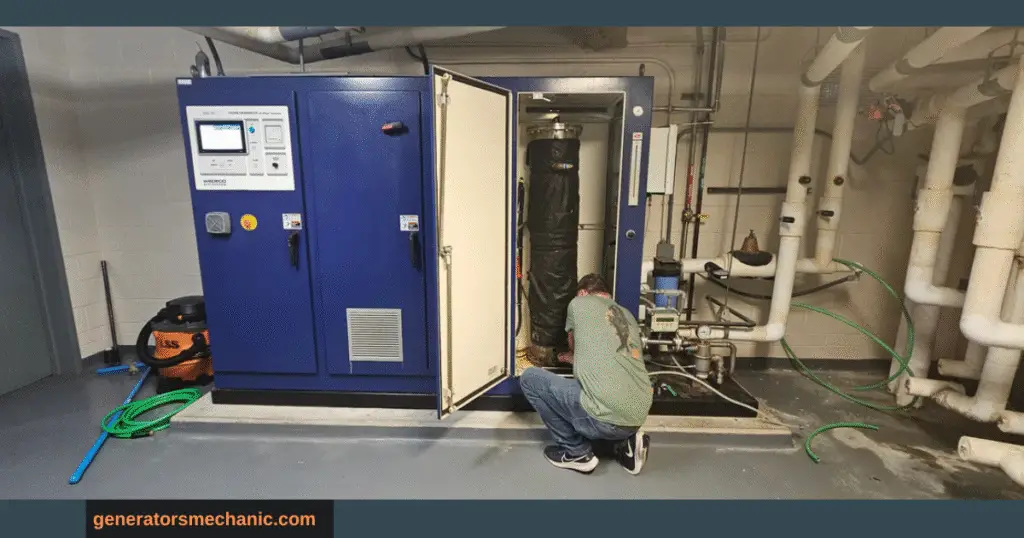
Regular Cleaning Procedures
Okay, so you’ve got an ozone generator. Cool! But like any other appliance, it needs some love to keep running smoothly. Regular cleaning is super important. Dust and grime can build up, especially on the ozone plates or UV lamps (depending on the type of generator you have), and that can seriously reduce its effectiveness.
Here’s a basic cleaning rundown:
- Unplug the generator. Safety first!
- Check the manufacturer’s instructions. They know best.
- Wipe down the exterior with a damp cloth. Nothing fancy.
- Clean the ozone plates or UV lamps. Use a soft brush or a slightly damp cloth. Be gentle!
- Let everything dry completely before plugging it back in. Patience is key.
I’ve found that setting a reminder on my phone helps me stay on top of the cleaning schedule. It’s easy to forget, but a little maintenance goes a long way.
Troubleshooting Common Issues
Things not working as expected? Don’t panic! Here are a few common problems and how to tackle them:
- Reduced ozone output: This could be due to dirty ozone plates, a failing UV lamp, or a problem with the power supply. Clean the plates, replace the lamp if needed, and check the power cord.
- Strange noises: If your generator is making weird sounds, it could be a sign of a loose component or a failing fan. Turn it off and inspect it carefully. If you can’t figure it out, contact the manufacturer.
- Error messages: Check the manual for the error code and follow the troubleshooting steps. Sometimes it’s as simple as resetting the device.
Extending the Lifespan of Your Generator
Want your ozone generator to last? Here’s the deal:
- Follow the manufacturer’s instructions. Seriously, read the manual.
- Clean it regularly. We already talked about this, but it’s worth repeating.
- Use it in a well-ventilated area. This helps prevent ozone buildup and reduces stress on the generator.
- Don’t overuse it. Ozone generators are powerful, but they’re not meant to run 24/7. Follow the recommended usage guidelines. If you need to know how to use our ozone generators, visit the Information Center page.
- Store it properly. When you’re not using the generator, store it in a cool, dry place. Avoid extreme temperatures and humidity.
By following these simple tips, you can keep your ozone generator running smoothly and efficiently for years to come.
Understanding Ozone and Its Properties
Ozone is a naturally occurring gas made up of three oxygen atoms, often found high in the Earth’s atmosphere, where it helps protect us from harmful UV rays. At ground level, ozone can also be produced artificially and is sometimes used in air purifiers or cleaning systems. While it has powerful disinfecting properties, ozone can be harmful if not handled correctly.
This is why many people often ask, Are ozone generators safe to use in homes or offices. The answer depends on how they are used—when operated in controlled conditions and unoccupied spaces, they can effectively eliminate odors and pollutants. However, direct and prolonged exposure to ozone is not recommended, as it can affect respiratory health. Understanding these properties is the first step to using ozone technology wisely and safely.

Chemical Composition of Ozone
Okay, so ozone. What is it, really? Well, it’s all about oxygen, but with a twist. The air we breathe is mostly made of oxygen molecules (O2). Ozone, on the other hand, is O3 – three oxygen atoms stuck together. That extra oxygen atom makes all the difference. It’s what gives ozone its special properties. Think of it like regular oxygen but with a bit of extra oomph.
Ozone vs. Oxygen
So, what’s the big deal with that extra oxygen atom? It makes ozone way more reactive than regular oxygen. That means it’s good at breaking down other stuff, like pollutants and odors. But it also means it can be harmful to us if we breathe too much of it. Regular oxygen (O2) is stable and happy to hang out. Ozone (O3) is a bit of a wild child, always looking for something to react with.
Natural Occurrence of Ozone
Where does ozone come from naturally? You’ll find it high up in the Earth’s atmosphere, forming the ozone layer that protects us from the sun’s harmful UV rays. It’s also created during lightning storms. That fresh, clean smell after a thunderstorm? That’s ozone! It’s nature’s way of cleaning the air. But, just because it’s natural doesn’t mean it’s always safe. Too much ozone, even from natural sources, can be a problem.
Ozone is a gas that occurs both in the Earth’s upper atmosphere and at ground level. It can be produced naturally or artificially. While it has beneficial uses, it’s important to remember that ozone can be harmful to human health, especially when inhaled in high concentrations.
Here’s a quick comparison:
|
Feature |
Oxygen (O2) |
Ozone (O3) |
|
Chemical Formula |
O2 |
O3 |
|
Stability |
Stable |
Unstable |
|
Reactivity |
Low |
High |
|
Natural Sources |
Air |
Atmosphere, lightning |
|
Uses |
Breathing |
Purification, disinfection |
Wrapping It Up
So, there you have it! Ozone generators can be pretty handy for cleaning the air and getting rid of nasty smells. They work by turning oxygen into ozone, which then goes after pollutants and bacteria. Just remember, while they can be effective, you need to use them carefully. Too much ozone can be bad for your health, so always follow the guidelines from the manufacturer. If you’re thinking about getting one, make sure it fits your needs and that you’re ready to handle it safely. Overall, ozone generators can be a great tool for a fresher, cleaner environment when used right.
Frequently Asked Questions
What is an ozone generator?
An ozone generator is a machine that makes ozone, which is a special type of oxygen. It changes regular oxygen (O2) into ozone (O3) using electricity or UV light.
How do ozone generators work?
Ozone generators work by taking in oxygen from the air and using a high-voltage charge or UV light to turn it into ozone. This ozone can then help clean the air and kill germs.
What are the main uses of ozone generators?
Ozone generators are used for cleaning the air, removing bad smells, treating water, and even disinfecting surfaces.
Is using an ozone generator safe?
While ozone can be helpful, too much ozone can be harmful. It’s important to follow the instructions and use the generator in a safe way to avoid breathing in too much ozone.
What benefits does ozone provide?
Ozone is great for killing bacteria, removing odors, and breaking down harmful substances in the air and water.
How do I choose the right ozone generator?
When picking an ozone generator, think about what you need it for, read reviews, and compare different models to find the best one for your situation.

